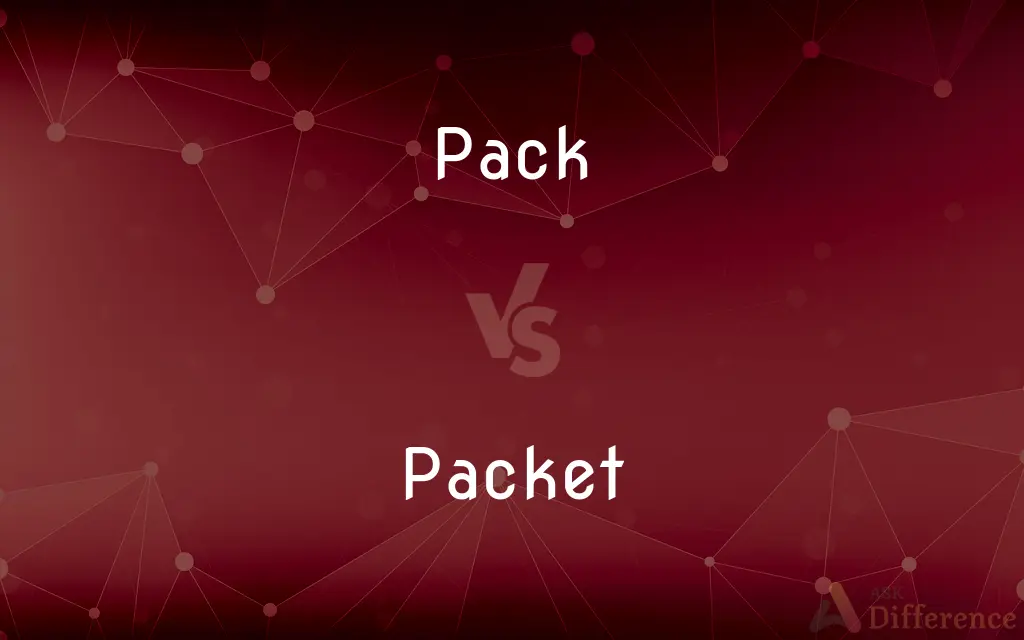Pack vs. Packet — What's the Difference?
By Tayyaba Rehman & Maham Liaqat — Updated on February 29, 2024
A pack refers to a collection or bundle of items held together, typically used for products like cigarettes or cards, while a packet is a small package or container, often used for enclosing small quantities of goods like ketchup or seeds.

Difference Between Pack and Packet
Table of Contents
ADVERTISEMENT
Key Differences
The term "pack" is broadly used to describe a grouping of similar items bundled together for sale, transport, or storage. It can refer to various products, from a pack of wolves in nature to a pack of cards or cigarettes in commercial contexts. "Packet" implies a smaller, often single-use container or wrapping, specifically designed to hold a small quantity of product.
Packs are generally larger and can contain either a single type of item or a collection of different items related by use or theme. Packets are commonly found in the food industry, such as sugar, ketchup, or mustard packets, and are designed for convenience and portion control. They can also refer to small envelopes containing non-food items, like seeds for planting.
Both packs and packets serve to contain and protect their contents, the scale and intent behind their use differ significantly. Packs are more about grouping and bulk handling, whereas packets focus on individual servings or quantities, emphasizing ease of use and distribution.
The choice between using "pack" or "packet" depends on the context of the items being described. For example, cigarettes are sold in packs, indicating a larger quantity, while condiments provided with takeout food are distributed in packets, denoting individual portions. This distinction reflects not only the physical size but also the intended use and consumer experience.
From a marketing perspective, packs might suggest value or quantity, appealing to consumers looking to purchase in bulk, while packets suggest convenience, cleanliness, and ease of use, catering to on-the-go consumption or single-use applications.
ADVERTISEMENT
Comparison Chart
Definition
A collection or bundle of items held together.
A small package or container for small quantities of goods.
Usage Context
Often used for groups of similar items like cards, cigarettes.
Typically used for single-use quantities, like condiments, seeds.
Size
Generally larger, containing multiple items.
Smaller, designed for individual servings or uses.
Examples
Pack of wolves, pack of gum, backpack.
Ketchup packet, seed packet, data packet.
Purpose
Grouping and bulk handling.
Convenience, portion control, single servings.
Compare with Definitions
Pack
A large grouping used for transport or sale.
She carried a pack of water bottles from the supermarket.
Packet
A small package for a single-use quantity of a product.
He opened a packet of ketchup for his fries.
Pack
A container or wrapper holding multiple items of the same type.
A pack of cigarettes is often shared among friends.
Packet
An enclosure for marketing or convenience purposes.
The sample shampoo came in a small plastic packet.
Pack
A collection of items or entities acting as a single unit.
The pack of wolves moved silently through the forest.
Packet
A container designed for individual servings.
The restaurant provides sugar packets at every table.
Pack
A bundle of similar items grouped together for convenience.
He bought a pack of gum before the road trip.
Packet
A small, sealed wrapper or envelope for goods.
She planted flowers from a packet of seeds.
Pack
An assembly of related items sold or used together.
The card game came with a new pack of playing cards.
Packet
A unit of data sent over a digital network.
The computer sent a packet of data to the server.
Pack
A collection of items tied up or wrapped; a bundle.
Packet
A small pouch, often consisting of two plastic or foil sheets sealed at the edges, used to distribute single portions of products in the form of liquids, powders, or small pieces
A ketchup packet.
Pack
A container made to be carried on the body of a person or animal.
Packet
A short block of data transmitted in a packet-switching network.
Pack
The amount, as of food, that is processed and packaged at one time or in one season.
Packet
To make up into a packet or bundle.
Pack
A small package containing a standard number of identical or similar items
A pack of matches.
Packet
To send in a packet or dispatch vessel.
Her husbandWas packeted to France.
Pack
A complete set of related items
A pack of cards.
Packet
A collection of things wrapped or boxed together
Pack
A group or quantity of connected or similar things; as, a pack of lies
Packet
A small package or bundle
Pack
A complete collection of similar things
Pack
Load with a pack
Common Curiosities
Can the term "pack" refer to digital items?
Yes, the term "pack" can refer to digital items, such as a pack of downloadable content (DLC) for video games.
How do manufacturers decide between packaging in a pack or packet?
Decisions are based on the product type, intended use, convenience, portion control, and marketing strategies.
Is a "pack" always larger than a "packet"?
Generally, yes, a pack is larger and contains more items or a larger quantity than a packet, which is designed for single or smaller uses.
Can you buy a single packet of a product?
Typically, packets are distributed in larger quantities or as part of a package, though some may be available individually depending on the product.
Can a packet contain multiple items?
While packets usually contain a single serving, they can hold multiple small items, like a packet of seeds containing several seeds.
How do sustainability practices influence the use of packs and packets?
Sustainability practices encourage the use of recyclable or compostable materials and designs that minimize waste, impacting how products are packaged.
Are packets only used for food products?
No, packets can be used for a wide range of products, including food, health and beauty samples, and even data in digital communications.
Can the content of packs and packets be the same?
Yes, the content can be similar, but the packaging form (pack vs. packet) affects the quantity and method of use or distribution.
Are packets environmentally friendly?
The environmental impact of packets depends on their materials and disposal methods; biodegradable or recyclable packets are more eco-friendly.
How does packaging affect the choice between a pack and a packet?
Packaging considerations include product protection, shelf life, user convenience, and cost, influencing whether a pack or packet is more suitable.
Do packs and packets have different storage requirements?
Yes, depending on the product, packs and packets may have different storage requirements to maintain freshness or integrity.
Do packs and packets have standardized sizes?
There are no universal standards for packs and packets; sizes vary by industry, product, and manufacturer.
What role do packs and packets play in marketing?
Packs and packets can influence consumer perception, with packs suggesting value and quantity, and packets emphasizing convenience and portion control.
Can the choice between a pack and packet affect product pricing?
Yes, packaging costs, material, and design can influence product pricing, with individual packets sometimes costing more per unit than bulk packs.
How do consumers benefit from packs and packets?
Consumers benefit from the convenience, portion control, and sometimes cost savings provided by packs and packets.
Share Your Discovery

Previous Comparison
Sestet vs. Sextet
Next Comparison
Freedom vs. AutonomyAuthor Spotlight
Written by
Tayyaba RehmanTayyaba Rehman is a distinguished writer, currently serving as a primary contributor to askdifference.com. As a researcher in semantics and etymology, Tayyaba's passion for the complexity of languages and their distinctions has found a perfect home on the platform. Tayyaba delves into the intricacies of language, distinguishing between commonly confused words and phrases, thereby providing clarity for readers worldwide.
Co-written by
Maham Liaqat












































